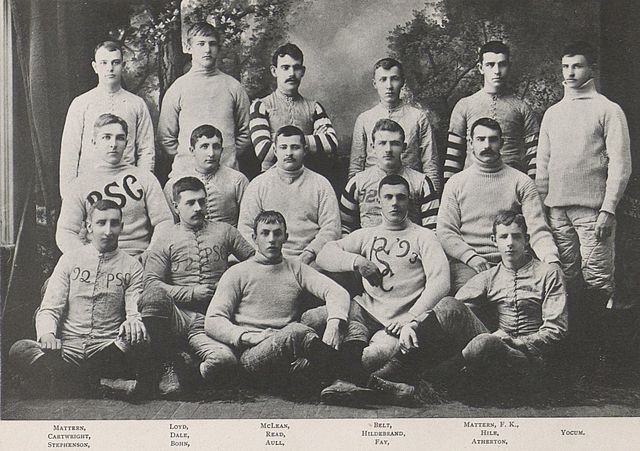In this edition of the Football History Rewind, we explore the 1889 & 1890 Rules revisions of Fair Catch & Half the Distance along with the turmoil and schools taking sides.
Football 1889 & 1890
Football 1889 and 1890
Eligibility Rules take Center Stage in Early Football

Courtesy Wikimedia Commons, A football team in 1890 wearing padded uniforms. Some of them are wearing nose guards around their necks.
Our story of football history left off as the Graduate Advisory Committee proposed a multitude of rules revisions in March 1889 that the Intercollegiate Association would have to examine at their next convention. The convention to ratify or dismiss these proposals did not occur in 1889 as turmoil enveloped the fledgling organization of football. One of the group’s major contributors, Harvard, was again threatening to leave the Association. Another, Yale, was rumored to be leaving the fold too. Could this be the end of the line for the great innovative body that was creating the very foundation of our era of football?
The Committee has spoken!
All research of 1889 rules revisions point to the very likely possibility that the recommendations of the Graduate Advisory Committee were accepted without a vote of the Association. All changes recommended were incorporated into the following season without one record of their being a convention in 1889.
.jpg)
The 1890 Harvard football team taken by an unknown photographer, Courtesy Wikimedia Commons
There was a huge debate between the member schools of the Intercollegiate Association on player eligibility rules. The bickering seems to have been so intense that it prevented the members to agree on much of anything even that of setting up a convention of its members for that year!
Walter Camp called the Graduate Advisory Committee together in a special session on 4 November 1889 to review a proposal he had made in ruling on who was eligible to play the games. Camp’s proposal was very detailed but incorporated the following points:
-Players must be bonafide students of the schools they played for.
-Players could not be paid or reimbursed in any way for playing football for the school.
- Other member schools could challenge eligibility of players in writing and that player in question could respond with a written affidavit proving he met the criteria to be eligible.
Mr. Duncan Edwards of Princeton offered some amendments to Camp’s proposal as to limiting the player’s eligibility to four years. This includes playing for other schools in the Association. Edwards also stated that he believed all players should have under-graduate status as a student at the member school.
Advisor H. C. Leeds of Harvard called out a point of order which stymied the adoption of the proposals from passing. His point was that the season was still in process and that the special session of the Advisory Committee was not able to constitute rules at this time per the Associations governing rules which said the Committee would meet in early May of each year. The point of order was not upheld but the rule amendments were defeated.
Leeds then filed protests on fifteen different Princeton players and Edwards countered with four protests of his own against Harvard players. The Committee was at an impasse, it would have to adjourn and meet again in a couple of weeks. A rift was evident in the Association putting Harvard and Yale on one side and Princeton, Wesleyan and Pennsylvania on the other. The other member schools took no solid stance as to place them on one side or the other.
The Committee met again on 14 November 1889 and didn’t really resolve anything there except that the chasm between the two sides was getting wider.

Courtesy Wikimedia Commons, from unknown photographer the 1890 Vanderbilt Commodores football team. Elliott Jones holds the football. Top row, left to right: A. Allen, end; P. H. Porter, guard; Pat M. Estes, quarterback; R. Allen, end; R. H. Mitchell, halfback. Second row - Horace E. Bemis, halfback; W. H. Hardin, center rush; Elliott H. Jones (capt.), fullback; B. Knapp, guard. Bottom Row - J. C. Wall, sub.; C. R. Baskerville, tackle; W. W. Craig, tackle. Herman Ruhm also was a sub on this team.
A Convention takes place of Committee session 10 May 1890
The Association hierarchy sensing the stalemate the Committee had in their previous two sessions decided to hold a convention in early May rather than hold another Committee meeting. The convention started off with an uproar as a letter was delivered to the delegation from Harvard announcing they were withdrawing from the Association. This news did not keep the convention from making progress though as they did incorporate some rules changes.

The 1890 team photo of the Penn State football team by an onknown camera person, courtesy Wikimedia Commons
The first change was quite interesting as it was the creation of two concepts that we carry in today’s rules. The Association adopted a rule revision in which the catcher of a kick that was fair caught would be protected via a 5 yard penalty against any opponent who would hit him after the fair catch was signaled. If the catch was within five yards of the goal line then the ball would be moved half the distance towards the goal line. Thus the first inkling of a half the distance penalty was created as well as fair catch protection.
Other rules amended were that of injured players who left the game and disqualified players being unable to enter the contest. Another new rule somewhat contradicted the earlier establishment of half the distance penalty, as it stated that off-sides penalties against a team inside their opponent’s five yard-line would constitute a touchback for the opposition.
Football was now entering its second decade with a much different look than it had started with. It also faced a lot of controversy and turmoil from within its ranks. Whether the Fathers of football knew it or not, bigger changes and obstacles were to face them in the new decade. Right here on PigskinDispatch.com, your place for the good news about football.
We are able to give this in depth look from so long ago in history by careful research. Using someone who was contemporary to the period is the best source. So a very special shout out to our main source of reference information for this article is from Parke H. Davis in his 1911 book Football-The American Intercollegiate Game.
Photo Credits
The picture in the banner above is from the Wikimedia Commons' collection. All are from unknown photographers but portray the 1890 teams of Harvard, Penn State and Vanderbilt.






